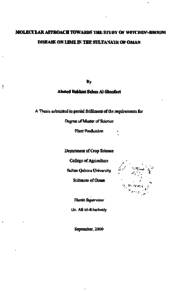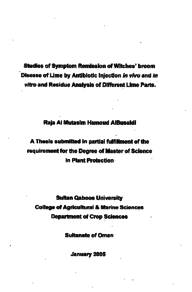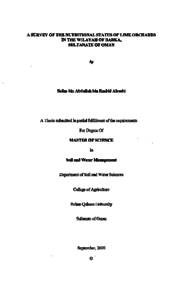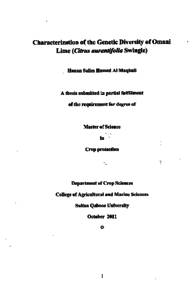Document
Molecular approach towards the study of witches'-broom disease on lime in the Sultanate of Oman
Publisher
Sultan Qaboos University
Gregorian
2000
Language
English
Subject
English abstract
Omani lime (Citrus aurantifolia) occupies a significant position among fruit crops in the Sultanate of Oman. In the late 1970s, a devastating disease called Witches'-Broom Disease of Lime (WBDL) was observed. The majority of dense lime orchards has been either killed or removed as a direct result of this disease. Nowadays, most of the mature lime trees are infected. This research attempted to develop protocols for accurate detection of the pathogen (Phytoplasma aurantifolia) in plant materials and in soil, and to determine if there are different strains of this phytoplasma.
As a first step a survey was carried out in four regions including Al-Batina, A'Dahira, the Interior, and A'Sharqia to study the relation of salinity, cultural practices, tree age, and die back disease to WBDL. There were positive correlations between the WBDL, tree age and salinity of soil and water up to certain level of salinity. However, the correlation was negative between the tree age and the healthy trees and trees infected with die back disease. On the other hand, there were no correlations between the WBDL and the cultural practices, except the negative correlation between the disease and intercropping system. There was no constant correlation between WBDL and die back disease.
For the molecular analysis, DNA was extracted from infected and healthy plant material and soil from different regions. Universal and early-published primers were used to detect the phytoplasma using the direct and nested Polymerase Chain Reaction (PCR) technique. The Restriction Fragment Length Polymorphism (RFLP) of the PCR products was used to study the relation between the Mycoplasma-Like Organism (MLO) genomic DNA amplified from the infected trees and the other infected corps. The two used protocols were successful in extracting the DNA from MLO pellet and from different plant materials and soil. Primer combinations that gave constant clear results were P1/P6 for direct PCR followed by WB3/WB2 for nested-PCR. The expected amplified products were obtained from all infected samples (1.5 Kb and 700 bp for direct and nested-PCR respectively). The symptomless trees were either free of the pathogen or they were carrying it for a long time without showing the symptoms. This last case may be due to the presence of genetic tolerance factors in these genotypes. While the disease was detected in seedlings obtained from a disease free area and maintained in the infected region for a few months, it was not detected in few lime trees in infected orchards. This might indicate the presence of genetic makeup that plays a role in the disease resistance. The presence of the phytoplasma in seeds from infected trees and in 20 days-old seedlings put forward the possible transmission of the disease through seeds.
The RFLP analysis showed no differences between phytoplasma in lime trees from different regions. It was clear that both alfalfa and papaya had different phytoplasma than the one that was present in lime trees.
An unexpected PCR product of 490 bp was found in six samples indicating the presence of another organism that may play a role in cross protection from WBDL. This can be seen in the absence of symptoms and causal agent of the disease in these trees and in some parts of an infected tree. In the latter case, the PCR analysis gave the eproduct for the pathogen in all parts of the infected tree except in the symptom top part where the unidentified new organism was detected.
Member of
Resource URL
Arabic abstract
يحتل الليمون العماني ( Citrus aurantifolia) مكانة مميزة بين محاصيل الفاكهة بسلطنة عمان . وفي أواخر السبعينات لوحظ إصابة هذا المحصول الهام بمرض مكنسة العجوز Witches ') المدمر والذي قضى على معظم بساتين الليمون العماني متسببا في موت الأشجار أو إزالتها. وحاليا فان معظم الأشجار المثمرة مصابة بهذا المرض. ويهدف هذا البحث إلى إيجاد طرق للكشف الدقيق على الكائن المسبب للمرض (Phytoplasma aurantifolia) في عينات التربة والنبات والمعرفة عما إذا كانت هناك سلالات أخرى لهذا المسبب.
كخطوة أولى تم مسح أربع مناطق مختلفة تضم الباطنة ، الظاهرة، الداخلية والشرقية لدراسة العلاقة بين هذا المرض وكلا من الملوحة ، المعاملات الزراعية، عمر الشجرة ، ومرض موت الأطراف (Die back). كانت هناك علاقات طر دية ( إيجابية ) بين مرض مكنسة العجوز وعمر الشجرة وكذلك ملوحة التربة والمياه إلى حد معين من الملوحة ، بينما كانت هناك علاقة عكسية ( سلبية ) بين عمر الشجرة والأشجار الخالية من المرض وكذلك المصابة بمرض موت الأطراف. من ناحية أخرى لا توجد هناك علاقة بين مرض مكنسة العجوز والمعاملات الزراعية ما عدا نظام التحميل (Intercropping System) فقد كانت العلاقة عكسية بينه وبين المرض. ليست هناك علاقة ثابتة بين مرض مكنسة العجوز ومرض موت الأطراف.
Broom Disease WBDL ) of lime بالنسبة للتحليل الجزيئي تم استخلاص الحامض النووي (DNA) من العينات السليمة وكذلك المصابة من النبات والتربة من مختلف المناطق. تم استخدام البادنات العامة (Universal primers) والمنشورة مسبق التعرف على الفايتوبلازما باستخدام تقنية (Direct and Nested Polymerase Chain Reaction ( PCR ثم استخدمت تقنية (Restriction Fragmet Length Polymorphism ( RFLP لمنتجات (PCR) لدراسة العلاقة بين الحامض النووي للمايكوبلازما المضخمة من أشجار الليمون والمحاصيل الأخرى المصابة. وقد نجحت الطريقتان المستخدمتان في استخلاص الحامض النووي من كريات المايكوبلازما ومن العينات المختلفة من التربة والنبات. أعطى اتحاد الباديات ( P1/ P6 ) و ( WB3 / WB2 ) نتائج واضحة وثابتة في كل من (Direct
كخطوة أولى تم مسح أربع مناطق مختلفة تضم الباطنة ، الظاهرة، الداخلية والشرقية لدراسة العلاقة بين هذا المرض وكلا من الملوحة ، المعاملات الزراعية، عمر الشجرة ، ومرض موت الأطراف (Die back). كانت هناك علاقات طر دية ( إيجابية ) بين مرض مكنسة العجوز وعمر الشجرة وكذلك ملوحة التربة والمياه إلى حد معين من الملوحة ، بينما كانت هناك علاقة عكسية ( سلبية ) بين عمر الشجرة والأشجار الخالية من المرض وكذلك المصابة بمرض موت الأطراف. من ناحية أخرى لا توجد هناك علاقة بين مرض مكنسة العجوز والمعاملات الزراعية ما عدا نظام التحميل (Intercropping System) فقد كانت العلاقة عكسية بينه وبين المرض. ليست هناك علاقة ثابتة بين مرض مكنسة العجوز ومرض موت الأطراف.
Broom Disease WBDL ) of lime بالنسبة للتحليل الجزيئي تم استخلاص الحامض النووي (DNA) من العينات السليمة وكذلك المصابة من النبات والتربة من مختلف المناطق. تم استخدام البادنات العامة (Universal primers) والمنشورة مسبق التعرف على الفايتوبلازما باستخدام تقنية (Direct and Nested Polymerase Chain Reaction ( PCR ثم استخدمت تقنية (Restriction Fragmet Length Polymorphism ( RFLP لمنتجات (PCR) لدراسة العلاقة بين الحامض النووي للمايكوبلازما المضخمة من أشجار الليمون والمحاصيل الأخرى المصابة. وقد نجحت الطريقتان المستخدمتان في استخلاص الحامض النووي من كريات المايكوبلازما ومن العينات المختلفة من التربة والنبات. أعطى اتحاد الباديات ( P1/ P6 ) و ( WB3 / WB2 ) نتائج واضحة وثابتة في كل من (Direct
Category
Theses and Dissertations




